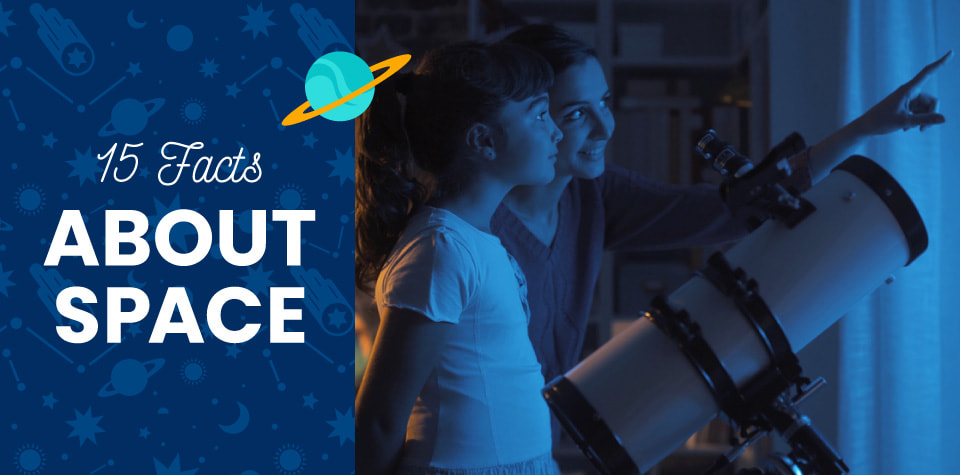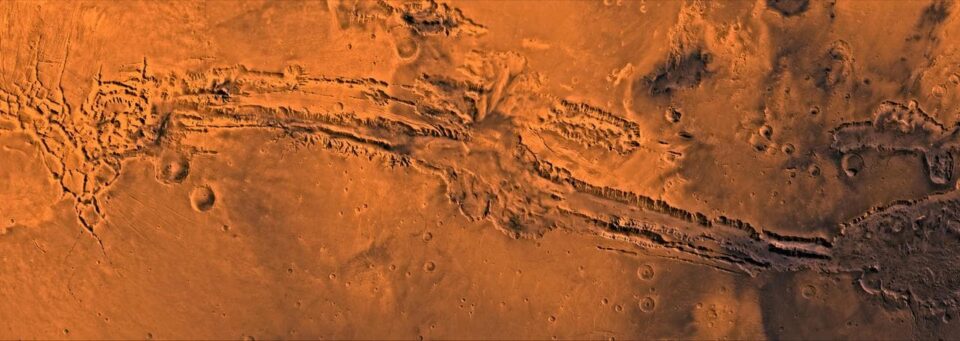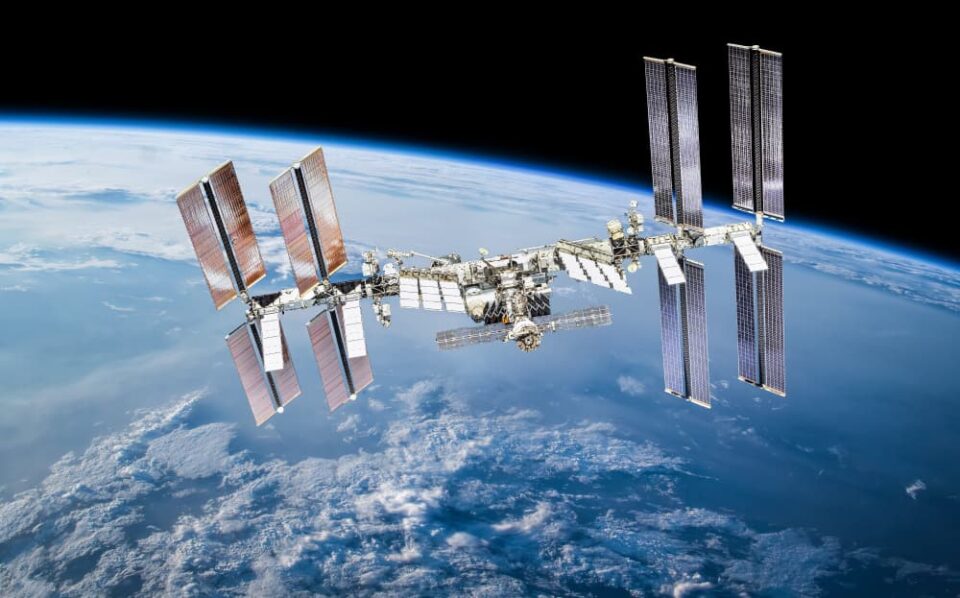
Lift Off to Discovery with 15 Facts about Space
Just like the universe, the curiosity many young explorers have about all that lies in the solar system—and beyond—is vast. Give them a start on exploring the cosmos by introducing them to these mind-boggling facts about space, the humans exploring it, and the celestial bodies that fill it.
The Big Empty
Let’s start with the big question: What is space?
Space is the extremely low-pressure area between galaxies, planets, stars, comets, and other celestial bodies. You might think it’s a big empty “nothing,” but that isn’t entirely true. Space is almost, but not quite, a perfect vacuum that contains trace amounts of gas and dust. If you were to use a scoop as big as Earth to harvest this free-floating material, you wouldn’t even capture enough air to blow up a child’s birthday balloon.
Does your space explorer crave more knowledge about all that lies beyond Earth? If so, they’re in luck! We’ve discovered a lot about space thanks to the Apollo and Voyager missions, the Hubble Space Telescope, the new James Webb Space Telescope, and other scientific instruments. Let’s explore more out-of-this-world space facts for kids.
Facts about Space and Planets
Let’s begin with these 10 facts about space.
- Librarians love it. Space is totally, completely, and entirely silent. That’s because there aren’t enough molecules close enough together to transmit sound waves.
- It’s getting messy. Humans have been exploring our solar system for about 60 years. During that time, we’ve left behind used rockets, dead satellites, and other equipment that continues to circle Earth at extremely high speeds. All this junk can be dangerous, so the Space Surveillance Network (SSN) has stepped in to track all that garbage and keep astronauts safe in orbit. They monitor more than 23,000 pieces of space debris.
- Red Planet blues. In 2015, astronomers were shocked when the Curiosity rover, NASA’s surface exploration vehicle, sent home images of a blue sunset over Mars. They determined that the dust found throughout the Martian atmosphere blocks the wavelengths of light that show up as red and yellow to human eyes but allows blue light to penetrate, causing the night sky to turn blue as the sun sets.
- A little extreme. If you were to ask most people, they would say that space is pretty cold. And it can be. In the darker regions of the solar system, temperatures can sink as low as -454°F (-270°C). That’s pretty cold! On the other hand, space can also bring on the heat. Temperatures in Earth’s orbit can reach as high as 250°F (121°C), hot enough to boil water.
- Space jewels. Orbiting a star similar to ours is a planet called 55 Cancri e. What makes this planet so fascinating? Astronomers believe that, instead of rock and dust, diamonds form the planet’s surface. 55 Cancri e is relatively close, only 41 light-years away. Unfortunately, it would still take a modern spacecraft more than 750,000 years to reach it. But maybe someday it will be worth a visit!
- A cosmic game of hide-and-seek. The solar system includes eight planets: Mercury, Venus, Earth, Mars, Jupiter, Saturn, Uranus, and Neptune, plus some dwarf planets, such as Ceres and Pluto. But did you know that astronomers suspect there’s a mysterious ninth planet—nicknamed “Planet Nine”—hiding far beyond Neptune’s orbit? Researchers believe its orbit is 20 times farther out than Neptune’s and that it takes anywhere from 10,000 to 20,000 years to orbit the Sun. Because it’s so far away, even the most high-tech telescopes have not been able to detect it yet.
- It’s getting a little crowded in some places. Astronomers recently discovered that the center of the Milky Way is filled with black holes. Black holes occur when massive stars collapse, creating an object with a gravitational pull so powerful that even light can’t escape it.
- Everything’s bigger in space. Just as Earth has many natural marvels, so do other planets. Mars’s biggest volcano, the Olympus Mons, is bigger than the entire state of Hawai’i. Its largest valley, Valles Marineris, is ten times longer than the Grand Canyon. An ongoing storm on Jupiter known as the Great Red Spot is so big that it could fit three Earths within its boundaries. Finally, one million Earths can fit inside the Sun. It’s more than enough to make you rethink the definition of “big.”
- Put a ring on it. Everyone is familiar with Saturn’s rings, but did you know other planets in our system also have rings? Uranus and Neptune each have a ring system. So does Jupiter. And when Mars’s moon Phobos crashes into the Martian surface fifty million years from now, astronomers expect it to also create rings.
- Some days drag on and on. On Venus, a year is only 225 Earth days long. But Venus rotates so slowly that a single day there lasts for 243 Earth days, meaning a year is shorter than a day. Wow!

Facts about Space Exploration
What’s it like to work and live in outer space? Let’s find out what life is like for astronauts exploring our solar system.
- Keep it chill. Given all the space dust they run into, you might wonder why astronauts’ space suits are white instead of another color that’s easier to keep clean. The answer is simple: White reflects sunlight and helps keep astronauts cool when they’re working in outer space.
- Smell that? It might surprise you to learn that outer space has a scent. Astronauts can’t detect it when they’re doing a spacewalk, but it can cling to their space suits and they can smell it when they get back to base. Some say it smells like gunpowder or burning metal or brake pads. Others describe it as a sweet smell like a burnt almond cookie.
- That will leave a mark. When Neil Armstrong and the rest of the Apollo astronauts visited the Moon, they each left a mark—their footprints. Moon rock wears down very slowly, about 0.04 inches every million years, meaning those prints will be visible for up to one hundred years.
- Break the bank. Going into space costs a lot of money. NASA paid twelve million dollars for each space suit in 1972. Making them today would cost one hundred and fifty million dollars. And that’s not the only expense. Every pound that gets launched into space costs about twenty-seven thousand dollars. That means if you wanted to take a twelve-ounce bottle of water into outer space, it would cost more than nineteen thousand dollars to get it there!
- It’s lonely up there. There’s only one spot in the whole of outer space where you can find humans living and working, and that’s the International Space Station (ISS). It’s the largest human-made structure to go into space, weighing more than 925,000 pounds and stretching more than 300 feet long. So far, 230 people from 18 countries have visited the station.

Who Turned Out the Lights?
Perhaps your space explorer has already studied the Big Bang and discovered that the universe is infinite and filled with more stars than grains of sand on Earth. But, if that’s the case, why does space look black? With so many shining stars out there, shouldn’t it be all lit up?
That’s a good question, one that scientists have been pondering for hundreds of years and still aren’t entirely sure about. One popular theory suggests that because the universe is approximately fifteen billion years old, on Earth, we’re only able to see stars that are as far away as the distance light can travel during that time. The light from anything farther hasn’t had enough time to reach us yet.
Also, not all stars and celestial bodies have a bright glow. The Andromeda galaxy—our nearest galactic neighbor—shines very dimly. You need a really dark sky to find it.
Did your space adventurer love discovering new fun facts about the universe? If so, fuel up for further adventures by studying the life cycle of a star or exploring the wonders of space flight. Kids can even craft a friendly astronaut to accompany them on their journey to the Moon and beyond.
If your child is keen to learn more about science and technology, why not subscribe to our Science Expeditions subscription box? Each box delivers experiments and activities to enthrall your young one as they explore a new STEM-based topic every month.
